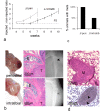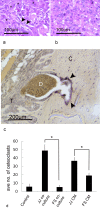New clinically relevant, orthotopic mouse models of human chondrosarcoma with spontaneous metastasis
- PMID: 20584302
- PMCID: PMC2902463
- DOI: 10.1186/1475-2867-10-20
New clinically relevant, orthotopic mouse models of human chondrosarcoma with spontaneous metastasis
Abstract
Background: Chondrosarcoma responds poorly to adjuvant therapy and new, clinically relevant animal models are required to test targeted therapy.
Methods: Two human chondrosarcoma cell lines, JJ012 and FS090, were evaluated for proliferation, colony formation, invasion, angiogenesis and osteoclastogenesis. Cell lines were also investigated for VEGF, MMP-2, MMP-9, and RECK expression. JJ012 and FS090 were injected separately into the mouse tibia intramedullary canal or tibial periosteum. Animal limbs were measured, and x-rayed for evidence of tumour take and progression. Tibias and lungs were harvested to determine the presence of tumour and lung metastases.
Results: JJ012 demonstrated significantly higher proliferative capacity, invasion, and colony formation in collagen I gel. JJ012 conditioned medium stimulated endothelial tube formation and osteoclastogenesis with a greater potency than FS090 conditioned medium, perhaps related to the effects of VEGF and MMP-9. In vivo, tumours formed in intratibial and periosteal groups injected with JJ012, however no mice injected with FS090 developed tumours. JJ012 periosteal tumours grew to 3 times the non-injected limb size by 7 weeks, whereas intratibial injected limbs required 10 weeks to achieve a similar tumour size. Sectioned tumour tissue demonstrated features of grade III chondrosarcoma. All JJ012 periosteal tumours (5/5) resulted in lung micro-metastases, while only 2/4 JJ012 intratibial tumours demonstrated metastases.
Conclusions: The established JJ012 models replicate the site, morphology, and many behavioural characteristics of human chondrosarcoma. Local tumour invasion of bone and spontaneous lung metastasis offer valuable assessment tools to test the potential of novel agents for future chondrosarcoma therapy.
Figures





References
-
- Pring ME, Weber KL, Unni KK, Sim FH. Chondrosarcoma of the pelvis. A review of sixty-four cases. J Bone Joint Surg Am. 2001;83-A:1630–1642. - PubMed
LinkOut - more resources
Full Text Sources
Miscellaneous

